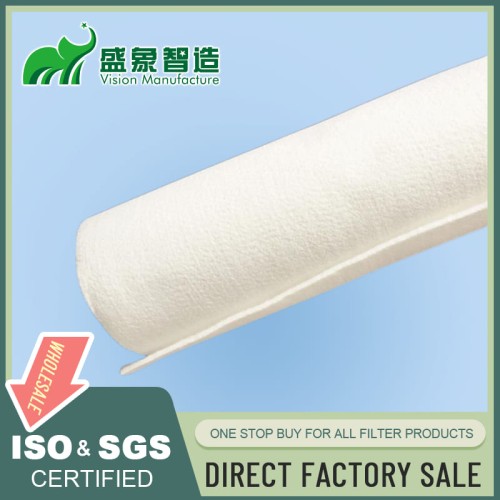
Polypropylene Felt Revolutionizes Industrial Filtration Processes
I. Introduction
Polypropylene felt is a pivotal material in the realm of industrial filtration, offering distinct advantages over traditional filter materials. This introduction explores the role of polypropylene felt in various industrial applications, highlighting its importance and the benefits it brings to enhancing filtration efficiency and operational effectiveness.
II. Properties of Polypropylene Felt
- Chemical Composition and Structure: Polypropylene is a thermoplastic polymer that offers excellent chemical resistance and stability.
- Physical Characteristics: Known for its lightweight, strong, and durable properties which make it suitable for demanding applications.
- Filtration Capabilities: Polypropylene felt provides effective particle retention and has a high dirt-holding capacity, making it ideal for various filtration needs.
III. Manufacturing Process
- Fiber Production: The creation of polypropylene fibers involves the polymerization of propylene.
- Web Formation Techniques: Methods such as melt-blown, spunbond, and carding are used to form the web structure of the felt.
- Needle Punching Process: Enhances the mechanical properties of the felt by entangling the fibers.
- Finishing Treatments: Including singeing, calendering, and heat setting to improve the filtration performance and durability of the felt.
IV. Types of Polypropylene Felt
- Standard Needle-punched Felt: Commonly used in various industrial applications due to its robustness and efficiency.
- Melt-blown Polypropylene Felt: Features finer fibers and a more random web structure for high filtration efficiency.
- Calendered Polypropylene Felt: Has a smoothed surface that enhances its ability to capture fine particulates.
- Specialty Blends and Composites: Developed for specific applications that require unique properties.
V. Applications Across Industries
Polypropylene felt is versatile and used across multiple sectors:
- Water and Wastewater Treatment: Essential for removing contaminants and purifying water.
- Chemical Processing: Filters out impurities that can affect chemical reactions and product purity.
- Food and Beverage Production: Ensures the safety and quality of food products by removing particulates.
- Pharmaceutical Manufacturing: Maintains contaminant-free conditions in drug production.
- Automotive Industry: Used in filtration systems to protect critical engine components.
- Environmental Protection: Plays a role in air pollution control and other environmental applications.
VI. Key Features and Benefits
- Chemical Resistance: Withstands various chemicals without degrading, making it suitable for harsh environments.
- Moisture Repellency: Prevents water absorption, which is crucial in wet filtration applications.
- Durability and Strength: Ensures a long service life even under challenging conditions.
- Cost-effectiveness: Offers a balance between performance and expense, making it a viable option for many businesses.
- Easy Cleaning and Maintenance: Simplifies upkeep and reduces downtime.
VII. Design Considerations
- Felt Thickness and Density: Tailored to meet specific filtration performance requirements.
- Surface Treatments and Finishes: Enhance the functional properties of the felt.
- Customization Options: Available in various configurations to suit different systems.
- Integration with Support Structures: Ensures compatibility with existing filtration setups.
VIII. Performance Characteristics
- Filtration Efficiency Ratings: High efficiency in capturing particulates.
- Flow Rate Capabilities: Maintains adequate flow rates to prevent system strain.
- Dirt-holding Capacity: Capable of retaining a significant amount of particulate matter.
- Pressure Drop Profiles: Designed to minimize pressure drops across the filter media.
IX. Installation and Usage
- Proper Handling Techniques: Essential to maintain the integrity of the felt during installation.
- Installation Best Practices: Ensures optimal fit and function within the filtration system.
- Initial Rinse and Preparation: Prepares the felt for operation, optimizing performance.
- Monitoring During Operation: Essential for maintaining efficiency and detecting issues early.
X. Maintenance and Cleaning
- Inspection Routines: Regular checks to ensure the felt is functioning properly.
- Cleaning Methods and Frequency: Guidelines for effectively cleaning the felt to maintain performance.
- Regeneration Techniques: Methods to restore filtration efficiency.
- Replacement Guidelines: Criteria for replacing the felt to ensure continuous system performance.
XI. Environmental Considerations
- Recyclability of Polypropylene: Highlights the sustainability aspects of using polypropylene felt.
- Energy Efficiency in Production and Use: Discusses how the material contributes to energy savings.
- Waste Reduction Strategies: Focuses on minimizing waste through effective filtration and material reuse.
- Comparison with Other Filter Materials: Evaluates the environmental impact relative to other filtration media.
XII. Case Studies
- Improving Water Filtration Efficiency: Demonstrates how polypropylene felt has enhanced water treatment processes.
- Enhancing Chemical Processing: Shows the role of polypropylene felt in maintaining product purity in chemical applications.
- Solving Challenging Filtration Issues: Discusses complex filtration challenges where polypropylene felt provided solutions.
- Optimizing Industrial Air Quality: Highlights improvements in air filtration systems using polypropylene felt.
XIII. Technological Advancements
- Nanofiber-enhanced Polypropylene Felt: Innovations that improve filtration efficiency.
- Smart Felt with Embedded Sensors: The integration of technology to monitor and optimize filtration processes.
- Biodegradable Polypropylene Alternatives: Developments in sustainable filter materials.
- Advanced Surface Modification Techniques: Enhancements that improve the performance and lifespan of polypropylene felt.
XIV. Regulatory Compliance
- FDA Requirements for Food Contact: Ensures that polypropylene felt meets stringent health and safety standards.
- EPA Guidelines for Environmental Applications: Compliance with environmental regulations to ensure clean and safe operations.
- Industry-specific Standards and Certifications: Adherence to standards that govern specific industries and applications.
XV. Conclusion
Polypropylene felt is a cornerstone of modern industrial filtration, offering numerous benefits across various applications. As filtration technology evolves, this material continues to play a crucial role in enhancing system performance and meeting environmental standards. For industries looking to optimize their filtration processes, polypropylene felt offers a reliable and cost-effective solution.
Leave a comment

